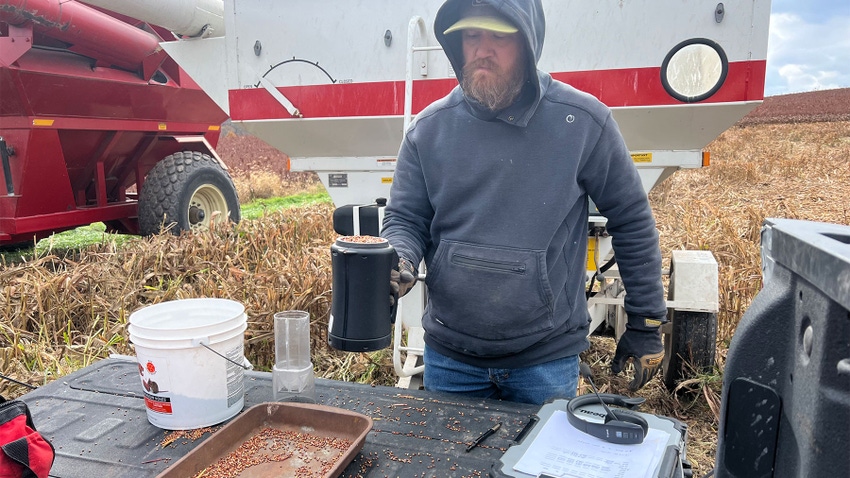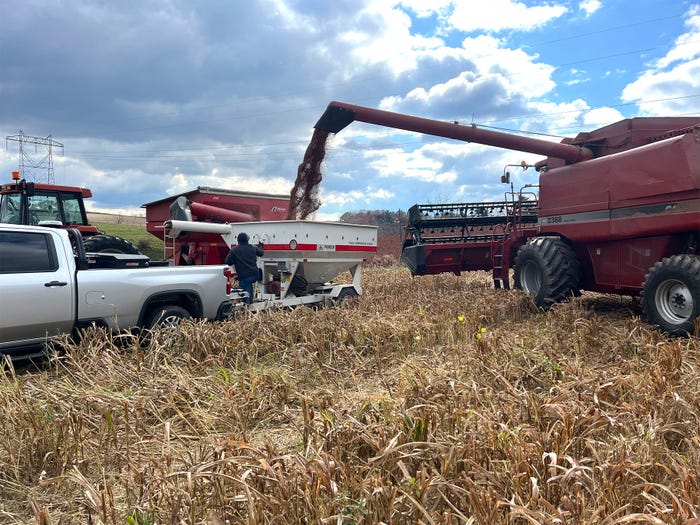
Salespersons can talk all they want about how their seed can help improve yields, or how their chemical can prevent disease or kill a pesky bug, but it ultimately comes down to what works on your farm — and that is the big reason on-farm testing is important to Dusty Kieffer.
“It is a passion project of mine,” he said during a recent webinar of the Pennsylvania 4R Alliance. “Really, at its core, on-farm testing is research and development, except it’s on the farm. Progressive farming operations are going to be doing this at some scale.”
Kieffer and his parents run the Mark M. Kieffer and Sons Farm in Dornsife, Pa., a 3,000-acre farm that grows barley, corn, sorghum, soybeans, sunflowers and wheat. He also sells Pioneer seed and is an independent dealer of Pivot Bio products.
What he tested this year
Kieffer devoted 12 acres of corn, 10 acres of soybeans and 2 acres of his other crops to test plots this past season.
He did 36 strip trials in corn, including side-by-side tests of corn hybrids, a test of Pivot Bio, trials on nitrogen delivery methods at planting and foliar nutrient treatments.
On soybeans, he set up an R2 treatment test with 20 trials at two separate sites, a trial looking at the effects of Source on his soybeans, and a trial looking at sulfur and potassium amendments.
He also did a sunflower variety trial, the second year he’s grown the crop.
“The reason is because I have to get a soybean replacement on drought-prone acres,” Kieffer said of the sunflower trial. “This bore a lot of fruit because I found a good variety that was better suited for my farm.”
For sorghum, he looked at fungicide sprays at boot stage to reduce disease. He also planted 200 acres of corn and soybeans green, keeping data on how that went.
All this testing provides results that either tell him to continue with a certain product or to move on.

HARVEST: Workers at the Mark M. Kieffer and Sons Farm harvest test plots on a recent day. Dusty Kieffer says communication and coordination are critical to having successful test plots.
But testing isn’t cheap and not for the faint of heart. “There is definitely a cost to it,” Kieffer said, adding that he needs extra labor to set up the trials. There is also the cost of having to buy extra products and having to upgrade equipment to accommodate a trial.
There is another pivotal cost to his operation.
“It costs leadership capital and goodwill with your team to rally them around something,” Kieffer said. This is something he admits he is still working on.
“I tried to step up my game this year. It felt like for two to three years that we would get it going, but I dropped the ball later on in the year to communicate with combine operators to get these plots harvested. It stunk. I was disappointed,” he said.
So, this year he developed harvest sheets for his workers, so they knew where the farm’s two combines had to be and at what time, and to have the correct data collection sheets available to get the job done.
His grain carts also have weigh scales, which he said allows his workers to keep track of more harvest data in real time and to allow more work to be done efficiently.
Kieffer has had some unexpected results from his testing. For example, in 2013-14, he did tests on adding sulfur to corn and whether it affects yields. He didn’t expect much of a result, but “I was amazed,” he said, adding that sulfur led to yield gains of between 20 and 32 bushels.
On the other hand, he tried a foliar nitrogen product on his soybeans last year hoping that it would lead to better yields. The results were negative. Maybe it was the fact that the beans were stressed by drought and disease, but nevertheless he was disappointed.
Continue or stop?
"It's kind of a stepped approach, and it depends on what I’m trying,” Kieffer explained.
First, he does test strips to “scatter that data out.” If it’s a success, he will do more trials the following year and collect more data. He is slow to add something new to the farm without data to back it up, but he added that he has seen incremental corn yield improvements from things he first tested in his trials. Soybeans, not so much.
For growers who want to set up trials, Kieffer said it gets harder once you involve multiple field operations to the mix. The “gateway” to starting an on-farm testing program, he said, is at planting with perhaps two to three different in-furrow operations in one pass. Once you involve a sprayer, or some other machinery, the operation gets a lot more complicated.
“Then you have to clean stuff out and all that sort of thing,” Kieffer said. “I put a 10-foot sprayer on a utility tractor for my plots. So, this is difficult, and you have to worry about coordination.”
When does he start trusting the results? “That depends. I’ll consider what the manufacturer or local field people say,” Kieffer said. “Also, once I start stringing together multiple years, I will trust the data more. And it also depends on replications.”
Not every farmer has the acres or equipment to accommodate large trials. Eric Rosenbaum, owner of Rosetree Consulting, said farmers should try two to three different things a year, look at how to position the product on the farm and then get some yield data.
“Try stuff out and have a plan to grab data,” Rosenbaum said.
In the end, Kieffer said farmers shouldn’t fall into the trap of what their neighbors are doing or what their salesperson is telling them to do. "That may be a good source of ideas, but that should be a funnel point,” he said. “Farmers should try those things out first.”
Setting up an on-farm trial
There are a number of online resources that can help you set up an on-farm trial.
Here are some tips from Iowa State University:
• Formulate a question that can be tested simply and effectively. The on-farm trial must be designed to fairly test the question without an outcome bias.
• Include a control treatment to test other treatments against. Controls are not used to adjust yield results, but rather to provide a baseline.
• Randomize and replicate to account for field variability and to build statistical power to detect differences between treatments.
• Consistent management practices across the field is a must. The only management factor to change is the factor being tested.
• Know the field history to avoid conducting a trial in an area where variability is high or something else may affect your results.
• Convince a neighbor to conduct the on-farm trial and share the data. This is a great way to conduct an on-farm trial on a different farm.
• Match equipment widths to ensure field operations can be conducted with ease. Treatments or strips dimensions must be equal to each other within the field, so that yield results match and each treatment is fairly evaluated.
• Use technology to your benefit. Guidance systems, monitors and prescriptions take the hassle out of conducting on-farm trials.
• Plant border rows between treatments or wider strips to buffer treatment effects from neighboring strips. This is particularly important for foliar applications, and if there is potential for lateral movement of nutrients such as nitrogen.
• Take notes and observe throughout the growing season to fully understand what impact is occurring because of treatment effects.
Other resources:
University of Nebraska-Lincoln
Videos:
About the Author(s)
You May Also Like






